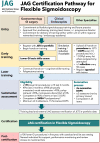JAG consensus statements for training and certification in flexible sigmoidoscopy
- PMID: 37056324
- PMCID: PMC10086722
- DOI: 10.1136/flgastro-2022-102259
JAG consensus statements for training and certification in flexible sigmoidoscopy
Abstract
Introduction: Joint Advisory Group (JAG) certification in endoscopy is awarded when trainees attain minimum competency standards for independent practice. A national evidence-based review was undertaken to update standards for training and certification in flexible sigmoidoscopy (FS).
Methods: A modified Delphi process was conducted between 2019 and 2020 with multisociety representation from experts and trainees. Following literature review and Grading of Recommendations, Assessment, Development and Evaluations appraisal, recommendation statements on FS training and certification were formulated and subjected to anonymous voting to obtain consensus. Accepted statements were peer-reviewed by national stakeholders for incorporation into the JAG FS certification pathway.
Results: In total, 41 recommendation statements were generated under the domains of: definition of competence (13), acquisition of competence (17), assessment of competence (7) and postcertification support (4). The consensus process led to revised criteria for colonoscopy certification, comprising: (A) achieving key performance indicators defined within British Society of Gastroenterology standards (ie, rectal retroversion >90%, polyp retrieval rate >90%, patient comfort <10% with moderate-severe discomfort); (B) minimum procedure count ≥175; (C) performing 15+ procedures over the preceding 3 months; (D) attendance of the JAG Basic Skills in Lower gastrointestinal Endoscopy course; (E) satisfying requirements for formative direct observation of procedural skill (DOPS) and direct observation of polypectomy skill (SMSA level 1); (F) evidence of reflective practice as documented on the JAG Endoscopy Training System reflection tool and (G) successful performance in summative DOPS.
Conclusion: The UK standards for training and certification in FS have been updated to support training, uphold standards in FS and polypectomy, and provide support to the newly independent practitioner.
Keywords: ENDOSCOPY.
© Author(s) (or their employer(s)) 2023. Re-use permitted under CC BY-NC. No commercial re-use. See rights and permissions. Published by BMJ.
Conflict of interest statement
Competing interests: ER has received research funding from Medtronic.
Figures

References
LinkOut - more resources
Full Text Sources
